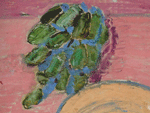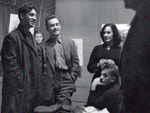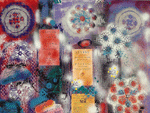Sources of thumbnails: WTL photographs© from Pierre Gauvreau; Passeur de modernité. Québec: Musée de la civilization, 2014. (Note: "Passeur de modernité" means "Ferryman of modernity.")
Comments: Pierre Gauvreau (1922 - 2011) is a multi-talented Québécois (i.e, from Québec province in eastern Canada) artist (painter, TV script writer and producer, and social activist within the arts communities in French Canada). He was born in the French-speaking neighborhood of Montreal in a solid, conservative, middle class Catholic family. However, due to his questioning nature and his wide ranging independent reading in art, science, and history he was declared persona non grata and expelled from his Jesuit high school (collège) and he soon became a life-long atheist. In 1938 he studied at the (at that time traditional, formal) École des Beaux-Arts de Montréal, which is now part of the (Francophone) University of Québec at Montreal.
During World War II, as a Canadian citizen, he joined the British Royal Air Force and was stationed ind Great Britain. Shortly after the war he was a leader of the French-Canadian modern arts movement known as Les Automatistes, whose manifesto, Refus global (1948), was written by the renowned Québécois artist Paul-Émile Borduas. Gauvreau, his brother Claude Gauvrear, and others were co-signers of this manifesto, which because the point of departure for the dynamic modernization of Québec society that has been going one steadily well into the 21st century. Les Automatistes, with Gauvreau as the inspirational leader on both TV and in his painting, was associated with but not directly involved in the revival of French Canadians pride in their distinct Latin language, culture, religion (Catholicism), and the like. This revival led to several attempts by social and political groups to gain independence from Anglo-Canada via democratic referendums. Such referendums came close to winning but they never achieved the threshhold of 50% of the popular vote. In 1976 he met Janine Carreau (b. 1948), who is an accomplished artist in her own right, as we shall see in the following pages. They remained a close and mutually loving couple until his death in 2011. We shall explore Gauvreau's works in the humanities--and some of Janine Carreau's also--(writing, film, painting) in the online pages of this sequential series.





